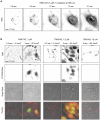Conjugation to the cell-penetrating peptide TAT potentiates the photodynamic effect of carboxytetramethylrhodamine
- PMID: 21423812
- PMCID: PMC3056768
- DOI: 10.1371/journal.pone.0017732
Conjugation to the cell-penetrating peptide TAT potentiates the photodynamic effect of carboxytetramethylrhodamine
Abstract
Background: Cell-penetrating peptides (CPPs) can transport macromolecular cargos into live cells. However, the cellular delivery efficiency of these reagents is often suboptimal because CPP-cargo conjugates typically remain trapped inside endosomes. Interestingly, irradiation of fluorescently labeled CPPs with light increases the release of the peptide and its cargos into the cytosol. However, the mechanism of this phenomenon is not clear. Here we investigate the molecular basis of the photo-induced endosomolytic activity of the prototypical CPPs TAT labeled to the fluorophore 5(6)-carboxytetramethylrhodamine (TMR).
Methodology/principal findings: We report that TMR-TAT acts as a photosensitizer that can destroy membranes. TMR-TAT escapes from endosomes after exposure to moderate light doses. However, this is also accompanied by loss of plasma membrane integrity, membrane blebbing, and cell-death. In addition, the peptide causes the destruction of cells when applied extracellularly and also triggers the photohemolysis of red blood cells. These photolytic and photocytotoxic effects were inhibited by hydrophobic singlet oxygen quenchers but not by hydrophilic quenchers.
Conclusions/significance: Together, these results suggest that TAT can convert an innocuous fluorophore such as TMR into a potent photolytic agent. This effect involves the targeting of the fluorophore to cellular membranes and the production of singlet oxygen within the hydrophobic environment of the membranes. Our findings may be relevant for the design of reagents with photo-induced endosomolytic activity. The photocytotoxicity exhibited by TMR-TAT also suggests that CPP-chromophore conjugates could aid the development of novel Photodynamic Therapy agents.
Conflict of interest statement
Figures






References
-
- Zorko M, Langel U. Cell-penetrating peptides: mechanism and kinetics of cargo delivery. Adv Drug Deliv Rev. 2005;57:529–545. - PubMed
-
- Maiolo JR, 3rd, Ottinger EA, Ferrer M. Specific redistribution of cell-penetrating peptides from endosomes to the cytoplasm and nucleus upon laser illumination. J Am Chem Soc. 2004;126:15376–15377. - PubMed
-
- Matsushita M, Noguchi H, Lu YF, Tomizawa K, Michiue H, et al. Photo-acceleration of protein release from endosome in the protein transduction system. FEBS Lett. 2004;572:221–226. - PubMed
-
- Endoh T, Sisido M, Ohtsuki T. Spatial regulation of specific gene expression through photoactivation of RNAi. J Control Release. 2009;137:241–245. - PubMed
-
- Woods LK, Morgan RT, Quinn LA, Moore GE, Semple TU, et al. Comparison of four new cell lines from patients with adenocarcinoma of the ovary. Cancer Res. 1979;39:4449–4459. - PubMed
Publication types
MeSH terms
Substances
Grants and funding
LinkOut - more resources
Full Text Sources
Other Literature Sources

